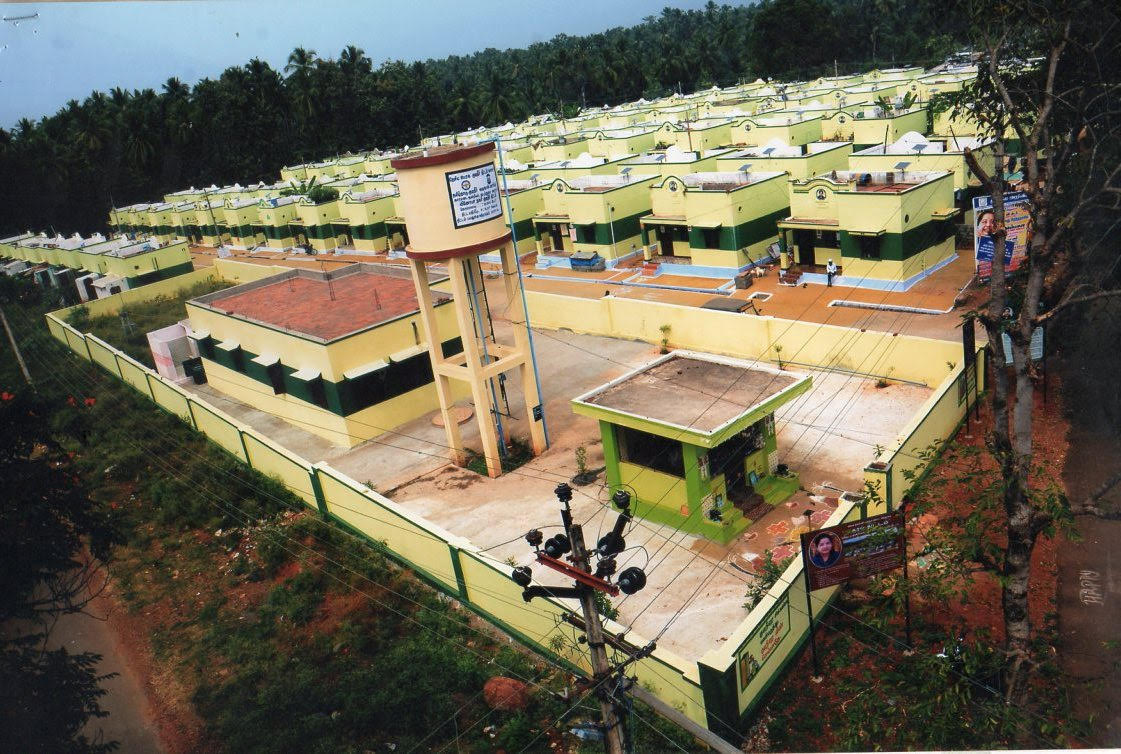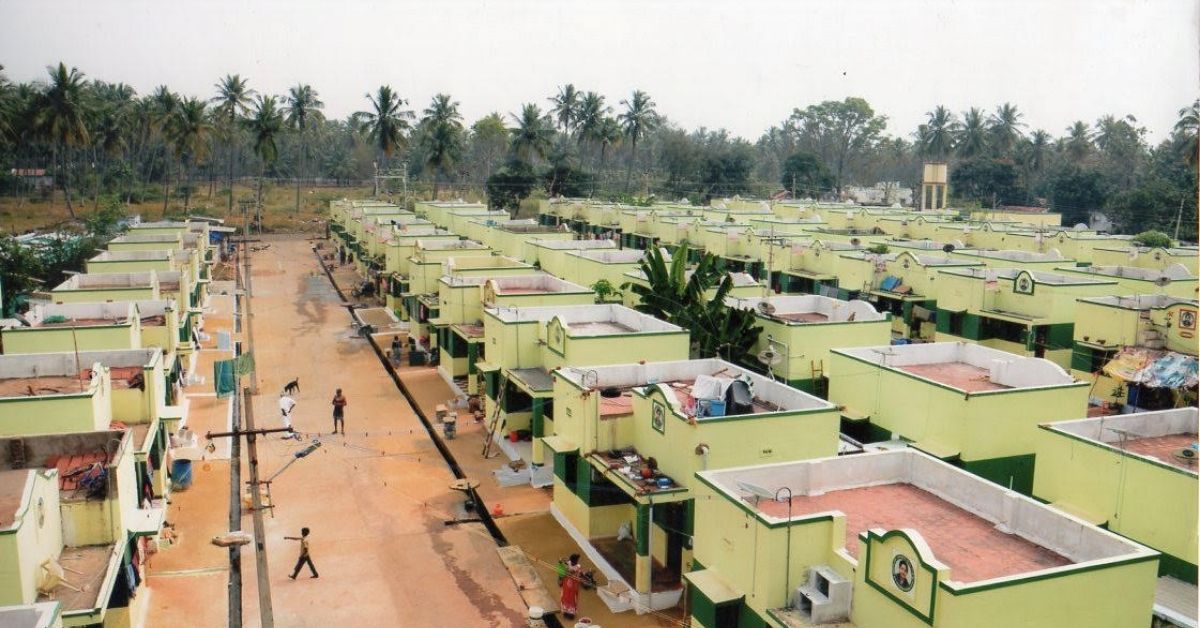“It is the first-ever wind power project in India undertaken by a local body,” R Shanmugam proudly boasts for the second time on the phone, to ensure that I hear him clearly on the phone amidst the swishing sound of the windmill that was set up in 2006 at Maivadi, 120 kilometres from Odanthurai panchayat of Coimbatore district.
Switch to energy efficient fans and cut down your electricity bills by 65%. Check out affordable fans at The Better India Shop here.
Interestingly it was the same year when he finished his term as the Village Head of the Odanthurai panchayat.
Although he is no longer a government official, Shanmugam continues to visit the wind power plant whenever he gets an opportunity to check if it is running without any glitches.

Giving details about the windmill that is his brainchild, Shanmugam continues, “The 350 KiloWatt (KW) plant produces around six lakh units of electricity per year of which 2 lakh is sold to Tamil Nadu Electricity (TNEB), and the rest of it is used mainly for streetlights and drinking water pumping operations of the panchayat.”
While the windmill can produce sufficient power to give free electricity to every household in the panchayat, the houses are unfortunately still dependent on the state board.
The windmill is a high-tension (or high voltage) line (HT) that is suitable for heavy power industries and houses need low voltage. The turbine can be used for households only when the HT line is converted into a low-tension line, but it has to be done by the electricity board, explains the 64-year-old.
The panchayat, on an average, earns around 11 lakhs annually from selling electricity. With this money, last year, the panchayat was able to repay a bank loan of Rs 1.5 crore it had taken 13 years ago to set up the windmill plant.
The total cost of the plant was around Rs 1.55 crore. The remaining money was used from the panchayat’s fund.
The windmill also has a positive impact on the environment, says Shanmugam. It produces electricity without generating air pollution and carbon dioxide—that are otherwise generated by burning fossil fuels—and the turbine does not release emissions that pollute the air and water.
At a time when even major cities like Delhi and Bengaluru suffer from power cuts and depend on the government for 24×7 supply, Odanthurai has set an example for every local government body to fix its own power needs.
No wonder that researchers, World Bank experts, village administrations, IAS officers, students, and officials from the Ministry of New and Renewable Energy (among others) frequently visit the panchayat to study Shanmugam’s strategy of becoming less dependent on TNEB.
After explaining the technical details of the windmill, Shanmugam ends the conversation with a piece of advice, “Government schemes is the key to development. It was under the Remunerative Enterprises Scheme our proposal to set up the windmill was accepted, and the bank granted a loan of 1.5 crore.”
Farmer, Entrepreneur, Village Head: Shanmugam’s Journey To Power
In 1996, Shanmugam, a farmer by profession, was elected to power as Council President of Odanthurai. It was only after joining the government did Shanmugam realise the depth of the crisis that plagued his panchayat.
Reminiscing about the not-so-pleasant-days, he says, “Basic infrastructure like access to drinking water, road connectivity, street lights, sanitation and housing was missing in the panchayat. Of course, as a native, I knew these problems and would often complain about the government’s lack of apathy. But it was only when I came on this side of the table did I understand problems better.”
As a head, his priority was to make drinking water sufficient for all the 1,750 villagers back then. Besides providing borewells, water filtering station and overhead tanks to every household, he also arranged for a water pump to fetch water directly from the Bhavani river, nearby.
“We used the National Rural Drinking Water Programme to fund the drinking water project. As per the scheme 10 per cent money (Rs 4.80 lakh) was pooled from the village community and the Central government-funded the rest (Rs 480 lakh),” he says.
The panchayat was also instrumental in providing 500 street lights and new motors, filtering points and booster stations for the drinking water plant. However, this significantly increased the electricity bill of the panchayat from Rs 2,000 to 1.5 lakh in just two years.
More than half of our budget would be spent on power bills, thus depriving other sectors of other developmental work. I was forced to look for other alternative renewable energy sources, and that is when my journey began, he says.
Among all the options available, he found the biomass gasifier system most feasible. He even visited Baroda to learn its operations. After undergoing a training programme at Ankur Scientific Energy Technologies Pvt Ltd, Shanmugam set up a 9 KW gasifier.
The power derived from gasification is considered to be a source of renewable energy if the gasified compounds are obtained from biomass. Back in the 90s, the waste wood from sawmill was priced at 60 paise per kilo.
The gasifier system helped the panchayat reduce the pumping cost of drinking water by 50 per cent!
However, four years later, the price of wood waste increased to Rs 3.50 per kilo and one unit of electricity was Rs 1.75. Thus, the gasifier was discontinued, and electricity was sourced directly from TNEB.
After the gasifier episode, Shanmugam continued his research of renewable sources, and at one of the conferences, he came across the concept of solar street lights.
He installed 2KW solar systems in two villages of the panchayat, and this saved Rs 5,000 on panchayat’s electricity bill.
Shanmugam credits the above two experiments that paved the way for the giant windmill.
These experiments taught me two important things—to use electricity provided by the government as a stand-by option and secondly, money can not only be saved but also generated from greener alternatives. My learnings gave birth to the windmill, he says.
While Shanmugam is no longer a government official, he provides his expertise to the panchayat every time there are doubts or questions raised about electricity. He is now working on a proposal to install solar panels in every house of the panchayat in collaboration with the village administrations.
Among the other initiatives undertaken by the Odanthurai panchayat, the Solar Powered Green House Scheme (SPGHS) stands out. Under this, since 1997, 950 houses have been built since for the villagers. As per the scheme, every house is built in an area of 300 square feet at a unit cost of Rs 2.5 lakh. While the government provided 1.80 lakh to every beneficiary, the remaining amount was given by the villagers themselves.
Each house is provided with a living room, bedroom, kitchen, toilet, verandah and a drinking water pipeline. Both the construction of houses and installation of solar lights were taken up by the Rural Development and Panchayat Raj Department.
Housing was another problem when I joined the government. We utilised the government scheme optimally, and today there are no homeless villagers in the entire panchayat and Odanthurai holds the record for the highest number of greenhouses in the state, claims Shanmugam.
The Odanthurai panchayat is indeed a model village for the entire country after producing its own power and provided drinking water and housing for all!
Also Read: Cool Just Your Bed: New Innovative AC Uses 65% Less Electricity!
(Edited by Gayatri Mishra)
Like this story? Or have something to share?
Write to us: contact@thebetterindia.com
Connect with us on Facebook and Twitter.
If you found our stories insightful, informative, or even just enjoyable, we invite you to consider making a voluntary payment to support the work we do at The Better India. Your contribution helps us continue producing quality content that educates, inspires, and drives positive change.
Choose one of the payment options below for your contribution-
By paying for the stories you value, you directly contribute to sustaining our efforts focused on making a difference in the world. Together, let's ensure that impactful stories continue to be told and shared, enriching lives and communities alike.
Thank you for your support. Here are some frequently asked questions you might find helpful to know why you are contributing?

